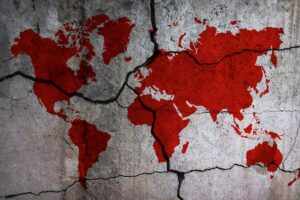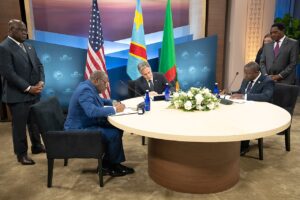The Red cell project
The Red Cell was a small unit created by the CIA after 9/11 to ensure the analytic failure of missing the attacks would never be repeated. It produced short briefs intended to spur out-of-the-box thinking on flawed assumptions and misperceptions about the world, encouraging alternative policy thinking. At another pivotal time of increasing uncertainty, this project is intended as an open-source version, using a similar format to question outmoded mental maps and “strategic empathy” to discern the motives and constraints of other global actors, enhancing the possibility of more effective strategies.
Reigning Assumption: The Biden administration and many other Western governments see the world as split between authoritarian systems and democracies. With regime type as the determining factor, the administration’s logic is that the United States can refashion a “democracies-only” order of trusted allies and partners, excluding China, Russia, and other hardline authoritarian regimes. Values trump interests in this bipolar organizing principle.
A Fragmenting World Order
The debate over whether the world is bipolar, as the Biden administration and many Western governments see it, or multipolar as the Global South, including Russia and China, contends, largely misses the point. Social science creates categories to classify phenomena, but the current fragmenting, transitioning world order is too complex and fluid for such analytical categories to be useful. Columbia University historian Adam Tooze captures the dynamic and the perils of the current global system:
How does a world function in which dollar hegemony is entrenched, security policy drives the formation of antagonistic blocs, the pattern of real economic activity is increasingly multipolar and the major issues of global public goods — climate and public health — go systematically unaddressed?
Mobilizing like-minded coalitions of mostly democracies on certain issues of shared concern — Ukraine or supply chains, for example — makes sense. But excluding China, the world’s second-largest economy and largest global creditor, as well as the two largest nuclear powers writ large is problematic. Even on select issues of shared interests and values, like-minded coalitions can be fragile and problematic. Elections can upend successful diplomatic gains. The United States under a second Trump administration might walk away from its European and Asian allies, pursuing an America-First strategy. Similarly, a populist right-wing win in Germany or France could weaken the transatlantic alliance as well as European integration. If the opposition in South Korea wins big in April’s parliamentary elections (more so if the left opposition wins the 2025 presidential elections), Seoul might distance itself from Washington on China and industrial policy issues. Or, now that pro-cross-straits-dialogue parties have gained the legislative upper hand coming out of Taiwan’s January elections, a divided government in Taipei might rebalance more toward China and less toward the United States.
Although tactically successful in propelling more regional cooperation, the Biden administration’s tendency to cooperate principally with democratic states (and friendly authoritarian ones like Saudi Arabia and the United Arab Emirates (UAE)) and institutions has triggered a backlash in Moscow and Beijing, which have forged closer ties despite differences over Russia’s invasion of Ukraine. Together they are re-energizing and expanding Brazil, Russia, India, China, and South Africa (the BRICS) and constructing an admittedly loose, transactional Eurasian entente: China-Russia-North Korea-Iran.
This renewed bipolar dynamic is unbalanced, creating a security dilemma and tit-for-tat behavior between the US-centric and Sino-Russian groupings: Both sides are seeking to bolster their security at the expense of the other, not understanding that the end result is greater insecurity for all players. At the same time, think tanks such as Australia’s Lowy Institute, which tracks the relative power of national players in its Asian Power Index, believe that the United States is relatively declining in strategic importance and cannot hope to exert primacy against China; in Lowry’s view, neither should a slower-growing China expect to be the dominant leader. This dynamic helps middle powers expand their clout on the world stage.
Increasing Influence of Middle Powers
Many middle powers are diversifying their partnerships — not wanting to align fully with either side — and know that their ability to overhaul the current bifurcating global order is limited. At the same time, the economic inequality gap between the G-7 and the Global South is growing. For these reasons, two Australian experts assess that middle powers have “tilted towards mini-lateral groupings and cooperation in the areas of security, technology, trade, and economy. The logic is simple, to achieve their national interests, middle-sized and like-minded formulas of cooperation are more effective than large, deliberative multilateral organizations.” Middle powers are, in effect, choosing not to choose.
Many middle power states like India, Indonesia, and Brazil eschew “naming and shaming” values–based diplomacy (the promotion of democracy, human rights, and progressive issues), seeing such moralizing as a danger to their pursuit of multi-alignments with both the United States and China. To protect themselves, they are closely integrated with China on trade and investments — on which their economic growth depends — but on other issues, such as China’s growing regional dominance, they have sought shelter under the U.S. security umbrella. There appears to be a somewhat schizophrenic pattern in Asia and the Middle East, where middle powers lean toward China, their largest trading partner, on economic issues but look to the United States on security, viewing Washington as the security guarantor of last resort.
Decline of the Multilaterals
One consequence of great power competition, obvious in the paralysis of the United Nations Security Council (UNSC), is that the much-needed reform and updating of multilateral institutions like the UN, World Trade Organization (WTO), World Health Organization, World Bank, and International Monetary Fund (IMF) has become exceedingly difficult. Consequently, these institutions are, in varying degrees, less fit to their purposes and increasingly ineffective in shaping solutions for a growing number of global challenges such as climate change, global health issues, trade rules, outer-space governance, emerging tech dilemmas, and debt forgiveness. Instead, many multilateral institutions have become platforms for bipolar “tit-for-tat” politics. This, in turn, fuels anger and resentment, increasing the divide between the West and the Rest.
Many middle powers distrust multilateral institutions like the UNSC or the Bretton Woods institutions because they see them as monopolized by or too beholden to the great powers. The G-7 nations, for example, have 59% of IMF voting rights with 14% of the world’s population. Even U.S. Treasury Secretary Janet Yellen has conceded that the World Bank should have been more activist in helping poor and developing countries deal with climate change. But the Biden administration has still insisted, over the opposition of many in the Global South, that the World Bank oversee the recently agreed-upon “damage–and–loss” funding to help poor countries deal with climate change. Until middle powers obtain more leadership positions, the legitimacy of multilateral institutions in the eyes of middle power governments will continue to decline.
Nonaligned to Multi-Aligned
Unlike the Cold War’s nonaligned movement, many Global South countries are not rejecting alignment but pursuing multi-alignment on specific issues, based on their calculus of their own interests, colonial legacies, and a sense of inequality on certain matters, such as economic or strategic issues like the wars in Ukraine or between Israel and Hamas.
Many Global South states see US-China competition as detrimental. Their prime interests and concerns are being ignored and they are thus in a hedging mode. The result has been an explosion in the issue-specific clusters of nations that are primarily concerned about their own interests, not necessarily the broader common interest as defined chiefly by the dominant states in the international system.
- Africa’s regional trade agreement, the Africa Continental Free Trade Area, developed owing to concern about the future of the WTO, which Africans and others saw was no longer being championed by the United States.
- On geoeconomics, generally, growing regionalization like the Comprehensive and Progressive Agreement for Trans-Pacific Partnership, as well as the pan-Asian Regional Comprehensive Economic Partnership and EU-Japan and EU-Korea trade agreements, have proliferated, with the United States choosing not to become a member of the Trans-Pacific Partnership or to continue talks on the proposed Transatlantic Trade and Investment Partnership after the 2016 election of Donald Trump.
- Encouraged by Washington, a thickening web of intra–Asian security cooperation has occurred in Asia — Japan-India, India-Vietnam, Japan-Vietnam, Japan-Philippines, as well as intra-ASEAN maritime cooperation — as Asians’ concerns about Chinese aggression in the South China Sea have intensified.
Are Alignments the Prologue to Unthinkable Alliances?
The alignments are bringing together countries that otherwise might not have cooperated with one another. The BRICS formation was originally modeled on the Goldman Sachs analysis of the most rapidly growing emerging nations in 2001. Much has changed since then. Saudi Arabia, Iran, Ethiopia, Egypt, Argentina and the UAE joined as of 1 January 2024, notwithstanding the fact that many are not growing economically very quickly. With such a diverse membership, it is hard to imagine that the BRICS grouping or many other alignments would congeal into formal blocs or alliances.
Washington, however, hopes that the various alignments it is fostering across South and Southeast Asia will become formal alliances or networks against China. Assistant Secretary of Defense for Indo-Pacific Affairs Ely Ratner has explicitly stated that the United States, with its two treaty allies (Japan and South Korea), as well as others such as Australia and India in the Quadrilateral Security Dialogue, is aiming for diversified mutual military access to allow for rapid power projection in case China invades Taiwan. The Biden administration also wants a networked security architecture that reinforces U.S. interests and values and increased allied and partner capabilities that strengthen deterrence while lowering costs for Washington.
Digging deeper, two think-tank researchers, Kelly Grieco and Jennifer Kavanagh, have found that achieving progress toward these goals has been slow. In a recently published Foreign Affairs article, they relate that “three years in, the United States still lacks the military access needed for a distributed force posture, its region-wide security architecture remains ill-suited to mobilizing a collective response to Chinese aggression, and its allies and partners continue to underinvest in their own defense.” It is conceivable but not inevitable that this broad US-led alignment could develop into an alliance should China decide to invade Taiwan. But all Asian countries depend on trade and investment from China and therefore do not want to antagonize Beijing; thus siding openly with Washington could have severe domestic consequences for them.
The transactional nature of the Sino-Russian-North Korea-Iran links is also important. Both China and Russia are fearful and distrustful of North Korea. Military cooperation between Russia and North Korea is based on Moscow’s needs for arms in its war against Ukraine. For its part, China fears that a burgeoning Moscow-Pyongyang partnership will reduce its influence over North Korea, a longtime client. In the Middle East, China, a leading importer of both Saudi and Iranian oil, is careful to balance its ties to Iran with those to the Saudis and the broader Gulf Cooperation Council.
Moreover, Sino-Russian relations have a long history of distrust and conflict. The current affinity is largely driven by mutual opposition to a US-led order. Under Russian President Vladimir Putin, Moscow has accepted being the junior partner, but another Russian president might well object to what is an increasingly lopsided arrangement. Isolated from the West with much of its trade crippled, Russia’s burgeoning economic ties with China are based on Beijing’s need for Russian oil and gas as well as other natural resources. Absent an easing of sanctions, Russia must rely on China for new investment in its energy infrastructure; so far, China has been driving a hard bargain, partly owing to fear of becoming too reliant on Russian energy. The Ukraine War, as well as Russia’s economic isolation, has provided an opening for the renminbi-based provision of consumer goods such as autos, grain, and textiles. Yet China’s integration into the global trade and financial system, and still-thick ties with the United States, complicate the strategic triangle.
In both cases, the United States’ growing ties to Asia, and a stronger, though not unlimited, Russo-China friendship that extends to others in Eurasia, the status quo is not unalterable. Loose alignments could be forged into what now appears to be an “unthinkable” alliance. The United States had close ties with Britain in the interwar period, but nothing suggested that Washington would come to the aid of Britain under Nazi attack. President Franklin D. Roosevelt struggled to sell the US-United Kingdom Lend-Lease program to an isolationist Congress and public. Only the Japanese surprise attack on Pearl Harbor brought the United States into a wartime alliance with Britain and the Soviet Union. The alliance with Britain expanded into a broader Atlantic Alliance after the war, even while ties with the Soviet Union were broken.
A “hot war” between the United States and China could be the catalyst for solidifying a Russo-Chinese alliance. In that case, Beijing would have a military incentive to help Russia fight its war in Ukraine in order to overextend the United States’ capabilities. Such a war would further decouple China from the West economically and financially in a way that Russia is already doing, pushing Moscow and Beijing even closer economically. This would be more problematic for other Asian countries in view of their economic dependence on China. But the economic disincentives for these countries to join the United States against China could lessen in view of the likely collapse of the global economy in this scenario given that the two are the world’s number one and number two economic powers respectively.
Conclusion
As noted earlier, Adam Tooze has said that this is a transitional world. By definition, transitions are transitory; climate change could become much more threatening than in recent decades, dwarfing all other concerns, and favoring a renewed effort at multilateral cooperation. At the other end of the spectrum, a major US-China war could occur with a collision over Taiwan, which could thin the ranks of the multi-aligned middle powers; some might be persuaded to believe it was in their interest to take sides. As such, war could solidify some of today’s loose alignments into full-fledged alliances, turning the global order into something more closely resembling the Cold War period with the Soviets.
The Red Cell thanks the Swedish Defence University for its support in the research and writing of this article.




